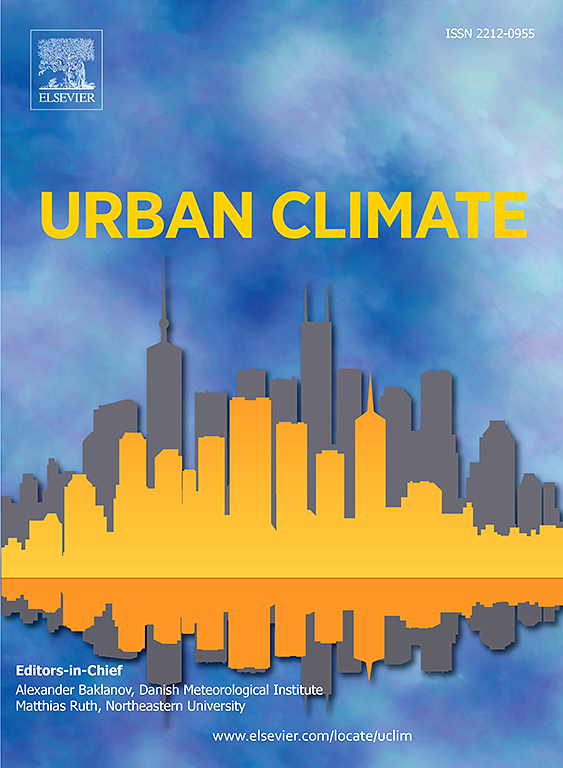Projection of precipitation and temperature in major cities of Pakistan using multi-model ensembles
IF 6.9
2区 工程技术
Q1 ENVIRONMENTAL SCIENCES
引用次数: 0
Abstract
This study projects future variations in monthly precipitation and average temperature in major cities of Pakistan. It constructs Multi-Model Ensembles (MMEs) by selecting 16 General Circulation Models (GCMs) from the Coupled Model Intercomparison Project Phase 6 (CMIP6). In this process, it utilizes an Artificial Neural Network-based statistical downscaling approach. The performance of these models was assessed using five statistical metrics: Correlation Coefficient, Nash–Sutcliffe Efficiency, Root Mean Squared Error, Kling–Gupta Efficiency, and the Modified Index of Agreement. The results show that MMEs outperform individual GCMs in simulating historical temperature and precipitation trends across the cities. Projections for 2024–2100, based on four Shared Socioeconomic Pathways (SSP1–2.6, SSP2–4.5, SSP3–7.0, and SSP5–8.5), reveal a decline in annual precipitation by 39.22 %, 48.79 %, 36.27 %, and 38.08 %, respectively. In terms of temperature, maximum temperature is projected to rise by 5.95 % (+1.85 °C), 12.79 % (+3.97 °C), 9.86 % (+3.06 °C), and 16.22 % (+5.04 °C), while minimum temperature is projected to decrease by 4.25 % (−0.76 °C) and 0.74 % (−0.13 °C) under SSP1–2.6 and SSP2–4.5, respectively. However, under SSP3–7.0 and SSP5–8.5, the results show that minimum temperature is expected to increase by 0.20 % (+0.04 °C) and 7.26 % (+1.30 °C), respectively. The greatest potential for precipitation decline is seen in Islamabad, Multan, and Sialkot. At the same time, higher increases in maximum temperature are expected in high-altitude cities like Quetta and Peshawar compared to low-altitude areas. This study provides essential insights to help urban policymakers and stakeholders develop targeted policies for addressing the impacts of climate change in cities.
使用多模式组合预测巴基斯坦主要城市的降水和温度
这项研究预测了巴基斯坦主要城市月降水量和平均气温的未来变化。本文通过选择耦合模式比对项目第6阶段(CMIP6)的16个环流模式(GCMs)构建了多模式集成(MMEs)。在此过程中,它采用了基于人工神经网络的统计降尺度方法。使用5个统计指标对这些模型的性能进行评估:相关系数、Nash-Sutcliffe效率、均方根误差、Kling-Gupta效率和修正的一致性指数。结果表明,MMEs在模拟城市历史温度和降水趋势方面优于单个gcm。基于四种共享社会经济路径(SSP1-2.6、SSP2-4.5、SSP3-7.0和SSP5-8.5)的预测,2024-2100年的年降水量将分别减少39.22%、48.79%、36.27%和38.08%。在温度方面,SSP1-2.6和SSP2-4.5条件下,预计最高气温将分别上升5.95%(+1.85℃)、12.79%(+3.97℃)、9.86%(+3.06℃)和16.22%(+5.04℃),最低气温将分别下降4.25%(- 0.76℃)和0.74%(- 0.13℃)。而在SSP3-7.0和SSP5-8.5下,最低温度分别升高0.20%(+0.04℃)和7.26%(+1.30℃)。降水量减少的可能性最大的地区是伊斯兰堡、木尔坦和锡亚尔科特。与此同时,奎达和白沙瓦等高海拔城市的最高气温预计将高于低海拔地区。本研究为帮助城市决策者和利益相关者制定有针对性的政策以应对气候变化对城市的影响提供了重要见解。
本文章由计算机程序翻译,如有差异,请以英文原文为准。
求助全文
约1分钟内获得全文
求助全文
来源期刊

Urban Climate
Social Sciences-Urban Studies
CiteScore
9.70
自引率
9.40%
发文量
286
期刊介绍:
Urban Climate serves the scientific and decision making communities with the publication of research on theory, science and applications relevant to understanding urban climatic conditions and change in relation to their geography and to demographic, socioeconomic, institutional, technological and environmental dynamics and global change. Targeted towards both disciplinary and interdisciplinary audiences, this journal publishes original research papers, comprehensive review articles, book reviews, and short communications on topics including, but not limited to, the following:
Urban meteorology and climate[...]
Urban environmental pollution[...]
Adaptation to global change[...]
Urban economic and social issues[...]
Research Approaches[...]
 求助内容:
求助内容: 应助结果提醒方式:
应助结果提醒方式:


